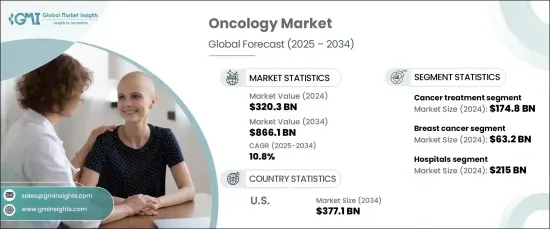
|
시장보고서
상품코드
1667183
종양학 시장 : 기회, 성장 촉진요인, 산업 동향 분석, 예측(2025-2034년)Oncology Market Opportunity, Growth Drivers, Industry Trend Analysis, and Forecast 2025 - 2034 |
||||||
세계의 종양학 시장은 2024년에 3,203억 달러에 이르렀고, 2025년부터 2034년에 걸쳐 CAGR 10.8%를 나타낼 것으로 예측됩니다.
종양학은 의학의 전문 분야로서 수술, 화학요법, 방사선요법, 표적요법, 면역요법 등의 폭넓은 전략을 통해 암 예방, 진단, 치료에 초점을 맞추었습니다. 종양학 연구의 진보는 암의 근본적인 원인이나 진행의 해명, 혁신적인 치료법의 개발, 환자의 결과의 개선을 목표로 하고 있습니다.

시장은 암 진단과 암 치료로 나뉩니다. 암 진단에는 영상 진단, 생검, 종양 바이오마커 검사, 액체 생체생성, 면역조직화학, in situ hybridization 등이 포함됩니다. 한편, 암 치료 분야에는 화학요법, 표적요법, 면역요법, 호르몬요법, 기타 개입이 포함됩니다. 2024년에는 암 치료 분야가 54.6%로 최대 시장 점유율을 차지했습니다. 이 증가는 인구 고령화, 라이프 스타일 변화, 환경 요인으로 인한 것입니다. 흡연, 식생활 교란, 운동 부족, 오염물질에 대한 노출은 세계 암 이환율 증가의 주요 요인입니다.
| 시장 범위 | |
|---|---|
| 시작 연도 | 2024 |
| 예측 연도 | 2025-2034년 |
| 시작 금액 | 3,203억 달러 |
| 예측 금액 | 8,661억 달러 |
| CAGR | 10.8% |
시장은 또한 유방암, 폐암, 전립선암, 대장암, 위암, 간암, 식도암, 기타 암 등 암유형별로 분류됩니다. 그 중에서도 유방암은 유병률의 상승과 조기 발견·치료의 진보에 대한 주목의 고조에 힘입어 여전히 수익면에서 주요 부문이 되고 있습니다. 그 요인으로는 유전적 소인, 고령화, 라이프 스타일의 변화 등을 들 수 있습니다. 특히 신흥 시장에서는 암 연구와 헬스케어 인프라에 대한 대규모 투자로 선진적인 진단법과 치료법에 대한 액세스가 더욱 향상되고 있습니다. 이러한 노력은 시장 성장을 가속화하고 전 세계적으로 환자 관리를 향상시키고 있습니다.
미국의 종양학 시장은 암 이환율의 상승에 견인되어 대폭적인 성장을 이루려고 합니다. 고령화나 생활습관의 리스크 등 요인이 헬스케어 시스템에 큰 수요를 가져오고 있어, 진보적인 치료나 진단 기술의 필요성을 부추고 있습니다. 암 부담 증가는 제약회사, 병원, 연구개발기관에 보다 효과적인 치료법, 진단법, 지원서비스의 혁신과 개발을 촉진하고 있습니다.
목차
제1장 조사 방법과 조사 범위
제2장 주요 요약
제3장 업계 인사이트
- 생태계 분석
- 업계에 미치는 영향요인
- 성장 촉진요인
- 세계의 암 이환율의 상승
- 정부 및 기타 조직에 의한 질병에 대한 인식을 넓히기 위한 여러 대처
- 신흥 국가의 진단 기관 수 증가
- 선진국에서의 기술 진보
- 업계의 잠재적 위험 및 과제
- 고액의 설비 투자와 화상 진단 시스템에 관한 고비용
- 암 치료에 수반하는 부작용이나 CT 스캐너에 수반되는 리스크의 높이
- 숙련된 훈련을 받은 종양학 의사나 방사선과 의사의 부족
- 성장 촉진요인
- 성장 가능성 분석
- 규제 상황
- 기술적 전망
- 향후 시장 동향
- 갭 분석
- Porter's Five Forces 분석
- PESTEL 분석
제4장 경쟁 구도
- 서론
- 기업 점유율 분석
- 기업 매트릭스 분석
- 주요 시장 기업의 경쟁 분석
- 경쟁 포지셔닝 매트릭스
- 전략 대시보드
제5장 시장 추계·예측 : 암 진단 및 치료별(2021-2034년)
- 주요 동향
- 암 진단
- 종양 바이오마커 검사
- 이미징
- 생검
- 액체 생검
- 면역조직화학
- in situ hybridization
- 암 치료
- 화학 요법
- 표적 요법
- 면역 요법
- 호르몬 요법
- 기타 암 치료
제6장 시장 추계·예측 : 암 유형별(2021-2034년)
- 주요 동향
- 폐암
- 전립선암
- 결장암 및 직장암
- 위암
- 식도암
- 간암
- 유방암
- 기타 암 유형
제7장 시장 추계·예측 : 최종 용도별(2021-2034년)
- 주요 동향
- 병원
- 진단 실험실
- 진단 영상 센터
- 학계
- 전문 클리닉
- 기타 최종 용도
제8장 시장 추계·예측 : 지역별(2021-2034년)
- 주요 동향
- 북미
- 미국
- 캐나다
- 유럽
- 독일
- 영국
- 프랑스
- 스페인
- 이탈리아
- 폴란드
- 스위스
- 네덜란드
- 아시아태평양
- 중국
- 인도
- 일본
- 호주
- 한국
- 태국
- 인도네시아
- 베트남
- 라틴아메리카
- 브라질
- 멕시코
- 아르헨티나
- 콜롬비아
- 중동 및 아프리카
- 남아프리카
- 사우디아라비아
- 아랍에미리트(UAE)
- 이스라엘
제9장 기업 프로파일
- AbbVie
- Amgen
- AstraZeneca
- Bristol-Myers Squibb Company
- Eli Lilly and Company
- GE HealthCare Technologies
- Gilead Sciences
- GlaxoSmithKline
- Johnson &Johnson
- Merck &Co
- Novartis
- Pfizer
- F. Hoffmann-La Roche
- Sanofi
- Takeda Pharmaceutical Company Limited
The Global Oncology Market reached USD 320.3 billion in 2024 and is projected to grow at a CAGR of 10.8% from 2025 to 2034. Oncology, as a medical specialty, focuses on preventing, diagnosing, and treating cancer through a wide array of strategies, including surgical procedures, chemotherapy, radiotherapy, targeted therapies, and immunotherapy. Advances in oncology research aim to uncover the underlying causes and progression of cancer, driving the development of innovative treatments and improving patient outcomes.

The market is divided into cancer diagnostics and cancer treatment. Cancer diagnostics include imaging, biopsies, tumor biomarker tests, liquid biopsies, immunohistochemistry, and in situ hybridization. Meanwhile, the cancer treatment segment covers chemotherapy, targeted therapies, immunotherapy, hormonal therapy, and other interventions. In 2024, the cancer treatment segment held the largest market share at 54.6%, supported by a rising global cancer burden. This increase is attributed to aging populations, changing lifestyles, and environmental factors. Smoking, poor diets, physical inactivity, and exposure to pollutants are key contributors to the increasing incidence of cancer worldwide.
| Market Scope | |
|---|---|
| Start Year | 2024 |
| Forecast Year | 2025-2034 |
| Start Value | $320.3 Billion |
| Forecast Value | $866.1 Billion |
| CAGR | 10.8% |
The market is further categorized by cancer type, including breast, lung, prostate, colorectal, gastric, liver, esophageal, and other cancers. Among these, breast cancer remains a leading segment in terms of revenue, fueled by its rising prevalence and growing focus on early detection and treatment advancements. Contributing factors include genetic predisposition, aging demographics, and shifting lifestyle patterns. Substantial investments in cancer research and healthcare infrastructure, particularly in emerging markets, are further improving access to advanced diagnostics and therapies. These efforts are accelerating market growth and enhancing patient care globally.
U.S. oncology market is poised for substantial growth, driven by the rising incidence of cancer cases. Factors such as an aging population and lifestyle risks are placing significant demands on healthcare systems, fueling the need for advanced treatments and diagnostic technologies. The growing burden of cancer is encouraging pharmaceutical companies, hospitals, and research institutions to innovate and develop more effective therapies, diagnostics, and support services.
Table of Contents
Chapter 1 Methodology and Scope
- 1.1 Market scope and definitions
- 1.2 Research design
- 1.2.1 Research approach
- 1.2.2 Data collection methods
- 1.3 Base estimates and calculations
- 1.3.1 Base year calculation
- 1.3.2 Key trends for market estimation
- 1.4 Forecast model
- 1.5 Primary research and validation
- 1.5.1 Primary sources
- 1.5.2 Data mining sources
Chapter 2 Executive Summary
- 2.1 Industry 3600 Synopsis
Chapter 3 Industry Insights
- 3.1 Industry ecosystem analysis
- 3.2 Industry impact forces
- 3.2.1 Growth drivers
- 3.2.1.1 Rising incidence of cancer globally
- 3.2.1.2 Several initiatives undertaken by government and other organizations to spread disease awareness
- 3.2.1.3 Growing number of diagnostic laboratories in developing countries
- 3.2.1.4 Technological advancements in developed countries
- 3.2.2 Industry pitfalls and challenges
- 3.2.2.1 High capital investment coupled with high cost associated with diagnostic imaging system
- 3.2.2.2 High risk of side effects associated with cancer treatment and risks associated with CT scanners
- 3.2.2.3 Dearth of well-skilled and trained oncologists and radiologists
- 3.2.1 Growth drivers
- 3.3 Growth potential analysis
- 3.4 Regulatory landscape
- 3.5 Technological landscape
- 3.6 Future market trends
- 3.7 Gap analysis
- 3.8 Porter’s analysis
- 3.9 PESTEL analysis
Chapter 4 Competitive Landscape, 2024
- 4.1 Introduction
- 4.2 Company market share analysis
- 4.3 Company matrix analysis
- 4.4 Competitive analysis of major market players
- 4.5 Competitive positioning matrix
- 4.6 Strategy dashboard
Chapter 5 Market Estimates and Forecast, By Cancer Diagnostics and Treatment, 2021 – 2034 ($ Mn)
- 5.1 Key trends
- 5.2 Cancer diagnostics
- 5.2.1 Tumor biomarkers test
- 5.2.2 Imaging
- 5.2.3 Biopsy
- 5.2.4 Liquid biopsy
- 5.2.5 Immunohistochemistry
- 5.2.6 In situ hybridization
- 5.3 Cancer treatment
- 5.3.1 Chemotherapy
- 5.3.2 Targeted therapy
- 5.3.3 Immunotherapy
- 5.3.4 Hormonal therapy
- 5.3.5 Other cancer treatments
Chapter 6 Market Estimates and Forecast, By Cancer Type, 2021 – 2034 ($ Mn)
- 6.1 Key trends
- 6.2 Lung cancer
- 6.3 Prostate cancer
- 6.4 Colon and rectal cancer
- 6.5 Gastric cancer
- 6.6 Esophageal cancer
- 6.7 Liver cancer
- 6.8 Breast cancer
- 6.9 Other cancer types
Chapter 7 Market Estimates and Forecast, By End Use, 2021 – 2034 ($ Mn)
- 7.1 Key trends
- 7.2 Hospitals
- 7.3 Diagnostic laboratories
- 7.4 Diagnostic imaging centers
- 7.5 Academia
- 7.6 Specialty clinics
- 7.7 Other end use
Chapter 8 Market Estimates and Forecast, By Region, 2021 – 2034 ($ Mn)
- 8.1 Key trends
- 8.2 North America
- 8.2.1 U.S.
- 8.2.2 Canada
- 8.3 Europe
- 8.3.1 Germany
- 8.3.2 UK
- 8.3.3 France
- 8.3.4 Spain
- 8.3.5 Italy
- 8.3.6 Poland
- 8.3.7 Switzerland
- 8.3.8 Netherlands
- 8.4 Asia Pacific
- 8.4.1 China
- 8.4.2 India
- 8.4.3 Japan
- 8.4.4 Australia
- 8.4.5 South Korea
- 8.4.6 Thailand
- 8.4.7 Indonesia
- 8.4.8 Vietnam
- 8.5 Latin America
- 8.5.1 Brazil
- 8.5.2 Mexico
- 8.5.3 Argentina
- 8.5.4 Colombia
- 8.6 Middle East and Africa
- 8.6.1 South Africa
- 8.6.2 Saudi Arabia
- 8.6.3 UAE
- 8.6.4 Israel
Chapter 9 Company Profiles
- 9.1 AbbVie
- 9.2 Amgen
- 9.3 AstraZeneca
- 9.4 Bristol-Myers Squibb Company
- 9.5 Eli Lilly and Company
- 9.6 GE HealthCare Technologies
- 9.7 Gilead Sciences
- 9.8 GlaxoSmithKline
- 9.9 Johnson & Johnson
- 9.10 Merck & Co
- 9.11 Novartis
- 9.12 Pfizer
- 9.13 F. Hoffmann-La Roche
- 9.14 Sanofi
- 9.15 Takeda Pharmaceutical Company Limited



















